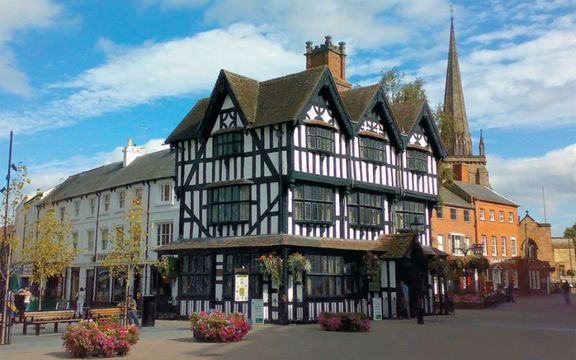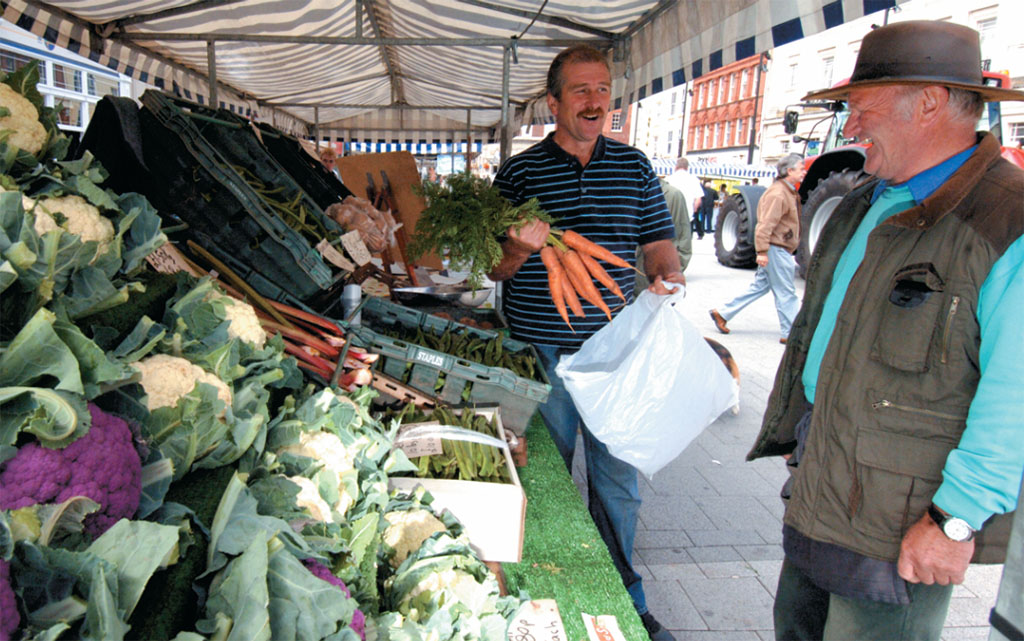
The black-and-white 17th-century “Old House” graces the High Street.Getty
The name “Hereford” comes from the Saxon “army ford”: a piquant thought as you cross one of today’s bridges over the River Wye—relatively recent, 15th to 20th-century constructions.
From the earliest times, this strategic military post on the borders with Wales played its bloody part in history, culminating in the Civil War when the city succumbed to Parliamentarian wrath.
The building of Hereford Cathedral began in 1079. Its dazzling new stained glass windows illustrate that the cathedral has always been a dynamic place.
Herefordshire’s county town adds an agreeable surprise to an itinerary. A neighbor of the Wye Valley, it’s also a manageable drive from Bristol, Gloucestershire, and the Cotswolds. Fortifications that once girdled the city have all but disappeared; the castle, too, has left barely a trace. The pervading atmosphere is of a market town snugly embedded in one of England’s least spoilt rural counties. Every week, people throng to the livestock and general markets.
A quick look at a city map reveals a surviving medieval street pattern and numerous historic buildings. Heritage Walk leaflets detailing a 90-minute circuit of river and town, available from the Tourist Information Centre, King Street, pinpoint the main sights. You’ll already have spotted the cathedral just a few steps from the TIC on the north side of the river. If for no other reason, come to Hereford for this—it has world-class treasures within.
Built on a place of worship since Saxon times, the present cathedral dates from the 11th century and its architecture unfolds an ongoing story through 900 years. Recently, a three-year art project has been completed to celebrate its three saints. Ethelbert, king and martyr, has been given a richly painted shrine to tell his story—he was beheaded in AD 794 by King Offa and, following a series of miracles, was buried on this site.
The 13th-century shrine of goodly St. Thomas of Hereford has been refurbished with a new canopy and embroidered hangings, and four swirling stained-glass windows have been dedicated to Thomas Traherne, Hereford’s 17th-century priest, poet and mystic. The unusual, colorful additions are startling—reviving the type of dazzling experience that medieval pilgrims would have enjoyed.
It certainly stirs empathy to view the cathedral’s world treasures through the eyes of their contemporary pilgrims. The Mappa Mundi in the New Library Building, a late 13th-century map of the world, is really a medieval encyclopedia on a 5 foot by 4 foot sheet of vellum. Faded by time, it nevertheless bursts with detail: countries, real and mythological creatures, people and events from the Bible, and history from the Creation to Domesday. Our forebears must have been agog! As an object of prestige, the Mappa Mundi may have helped with the campaign for the canonisation of Thomas of Hereford, forming part of the pilgrimage experience to his shrine. Once the central panel of a triptych, it could be revealed with a gasp-inducing flourish as part of the “show.”
Next door, the unique Chained Library houses books from the 8th to 19th centuries—the chains and bookcases, dating from the 17th century, show how our ancestors guarded against light fingers. Comprising many tomes on law and theology used in study and worship, the priceless collection numbers around 1,500 volumes.
You may want to sit and ponder it all, and the cathedral has a pleasant café. Then the Cathedral Close, undergoing a three-year, multimillion-pound enhancement, makes a gentle wander. Walk on past the (private) Bishop’s Palace south to the river where an 18th- and early 19th-century boat trade thrived. Back up and eastwards from the Bishop’s Palace, Castle Green, and Castle Pool recall the erstwhile royal castle and moat. The only stone that remains is the medieval watergate of the castle, which is now a private house called Castle Cliffe that offers characterful, four-star self-catering accommodation.
Opposite the cathedral on Broad Street is a building bristling with exuberant Victorian carvings of animals and birds: Hereford Museum and Art Gallery. A peek inside gives more insights into the city and region’s religious, military, and trading past—modest displays feature everything from a woolly mammoth tooth to Roman mosaics and Civil War boots. As to lunch, there’s plenty of fresh, local food to be had from Hereford’s rural surroundings.

The rich countryside around Hereford yields a local bounty on Market Day
Picturesque Church Street boasts numerous such individualistic shops, not to mention the birthplace in 1721 of Roger Kemble, founder of the theatrical dynasty that included Sarah Siddons. Another house belonged to a friend of composer Edward Elgar; the latter wrote some of his music here and, through the famous Three Choirs Festival that Hereford shares with Gloucester and Worcester, is closely associated with the cathedral.
Ramble along Church Street, through narrow Capuchin Lane to High Town: Now an open area lined by modern retail and the Butter Market, but once filled by rows of shops.
The other highlight is the Cider Museum, a few minutes west from the city center on Ryelands Street. Herefordshire is renowned as an apple orchard and cidermaking country—Bulmers, just up the road, is the country’s largest cider mill. The UK’s only museum entirely dedicated to the beverage is fittingly housed in an old cider-making factory. It’s an atmospheric affair featuring old wooden presses, aromatic cellars, and displays on production. Try a tipple from the on-site King Offa Distillery or other local ciders for sale. Cheers to historic, surprising Hereford.
* Originally published in 2016. Updated in 2023.





Comments